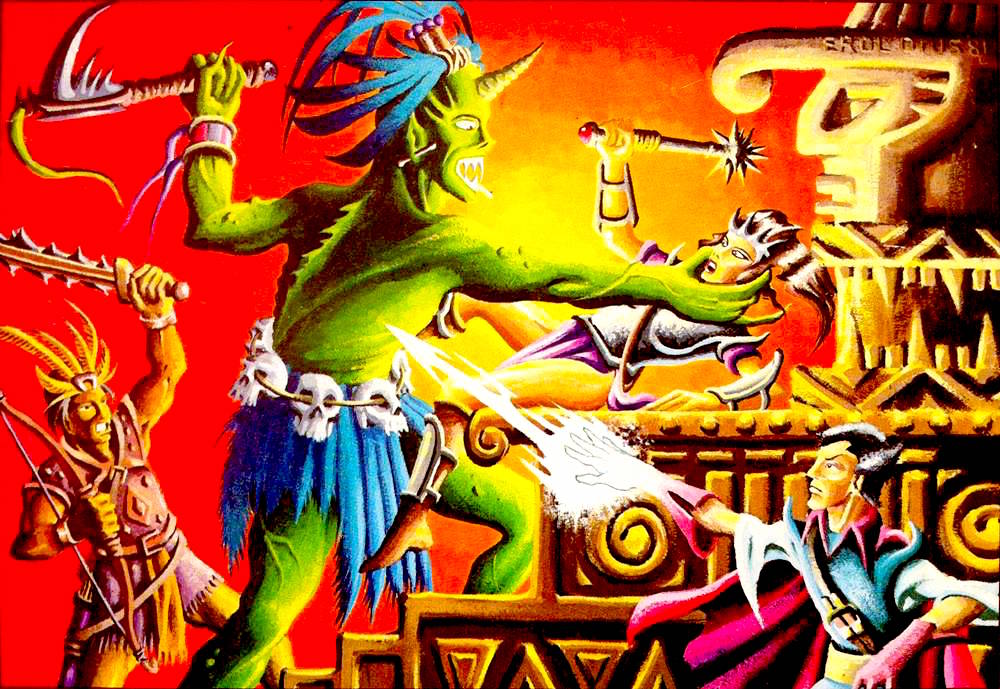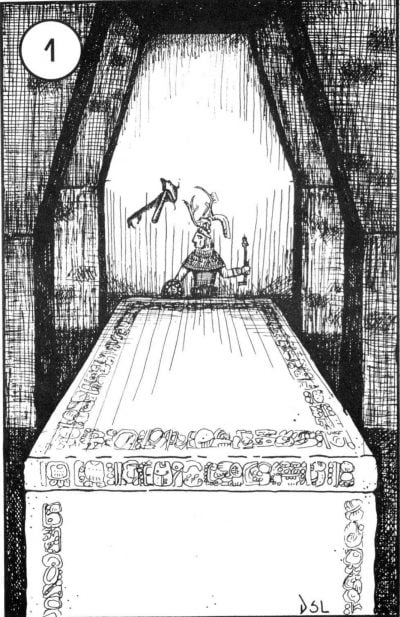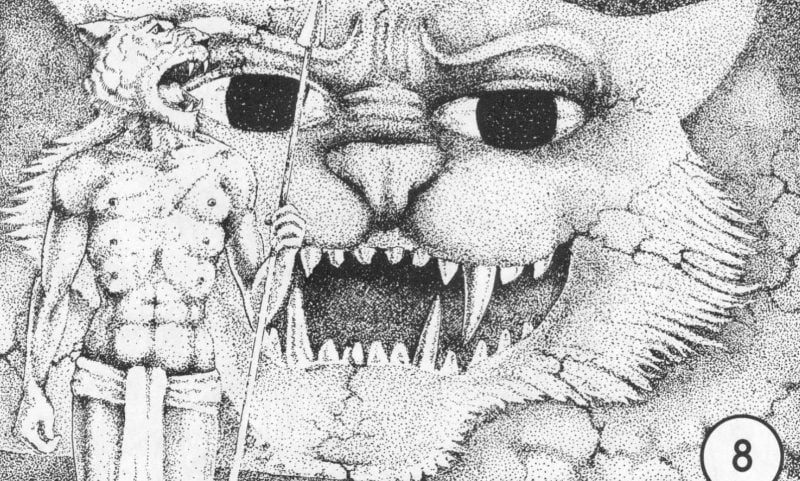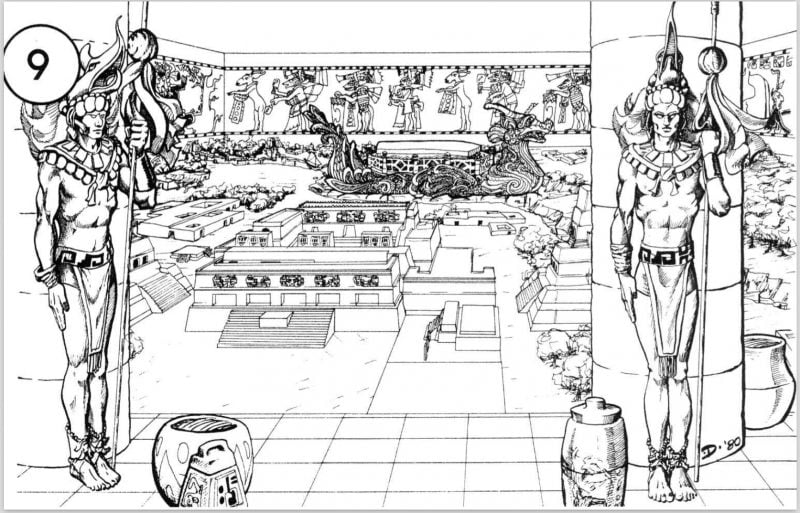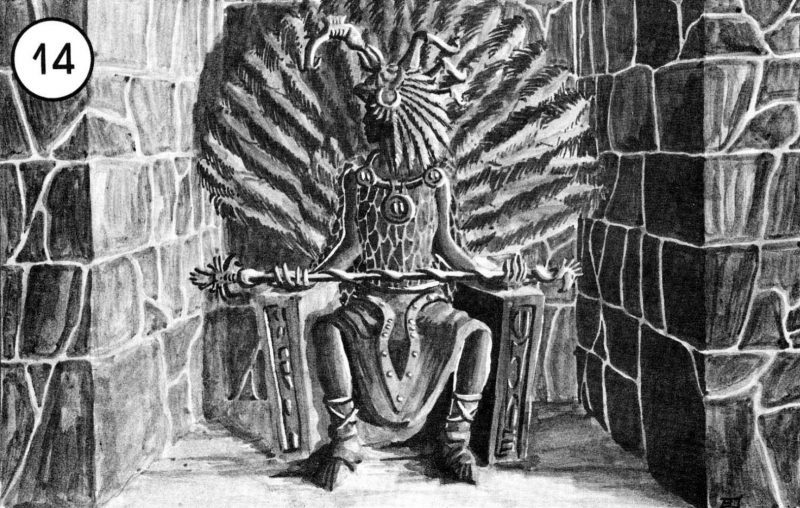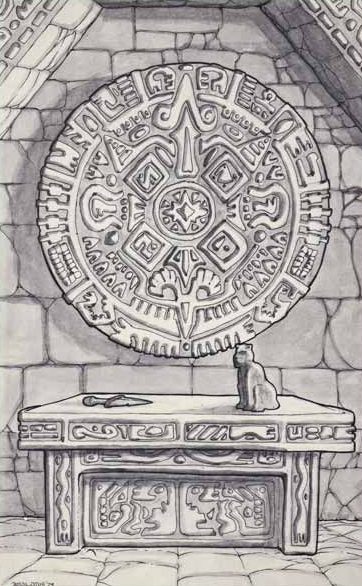Dungeon Design: Hidden Shrine of Tamoachan


The Hidden Shrine of Tamoachan is one of the greatest examples of dungeon design with character…
The Hidden Shrine of Tamoachan is one of my favorite dungeon modules. It’s challenging–but not necessarily because of the monsters. There are some interesting traps and vignettes, but more than anything else, what makes this dungeon stand out is the character to it. As you might have read in our coverage of either the Sunless Citadel or the Forge of Fury, there are a few different components to consider when talking about Dungeon Design–combat, puzzle, narrative, and reward.
And the Hidden Shrine of Tamoachan is a masterclass in narrative components. Let’s talk briefly about what a narrative component is, though, so we’re all on the same page. When I say narrative component, I don’t necessarily mean the plot of the dungeon–though that certainly can be a factor. But a narrative component doesn’t have to be the “evil druid is there to make evil plants and take over the world.” All a narrative component does, for dungeon design purposes, is reveal something about the world. And about how the dungeon fits into it. It’s what makes the Dungeon feel less like a random collection of rooms and more like an actual place.
It’s the shackles on the wall that say, “people were kept as prisoners here.” Or the subtle arcane runes that have been etched into the walls by the Lich at the heart of the tomb, or the way that the orcs have smashed things and left their trash littered about because they’re a bunch of bandits (good on you, Forge of Fury). The narrative component is what shows how the dungeon was used, and how it fits into the larger world as a whole.
So with that in mind, let’s dive into the rich narrative tapestries that you can find in the Hidden Shrine of Tamoachan…
The Hidden Shrine of Tamoachan
The dungeon itself is an ancient ruined temple–a hidden shrine to Zotzilaha, the vampire god of the underworld. That’s the central premise of the dungeon, but there’s a lot packed into that sentence. Zotzilaha is a vampire god of the Olman, a Mayan/Aztec/Toltec-inspired society (see above) full of traps and guardian beasts and so on. They aren’t a big civilization anymore, but that fact still colors everything about the dungeon.
Also I feel it’s worth mentioning that just because we’re talking about narrative components specifically, it doesn’t mean we will be leaving off combat or other mechanics–a lot of times, a combat encounter can serve as a narrative component, especially in this dungeon. Same with the puzzle/traps portion. In fact, before the players have even entered the dungeon, you’re presented with some narrative complications in the form of Unsafe Stonework (the shrine is old and decayed, and there’s a chance that explosive spells will cause a ceiling collapse) and a poisonous gas which fills the lower levels of the room. Both of these are threats to the players that they’ll have to deal with, but they also help sell the idea that this shrine has been sitting here undisturbed for untold centuries (before the players literally fell upon it).
But there are a few places where the narrative component really shines. Unfortunately this means we’ll skip past my favorite part of the dungeon (an encounter with a giant talking hermit crab and his giant crayfish buddy), but there’s still plenty to delve through.
For starters there’s the Apartment of the Dust of Ages (Room 36 for those of you playing along at home):
The floor of this room is covered with a layer of fine gray dust and ash, three inches deep. Across the room, opposite where you entered, is another set of double doors. There are two empty alcoves to the north and south. On small ledges in each corner of the room are pieces of what appear to be broken pottery.
As you move into the room, your steps send motes of dust and ash swirling into the air, and these clouds form into shapes.
AdvertisementFirst, from the ash, a dusty phantom assumes the shape of a woman. Her face is forlorn and tear-streaked. She throws up her hands in despair, rushes into one of the alcoves, and disappears. Immediately afterward, two more dusty phantoms emerge–mighty warriors armed with jagged-edge swords and bearing fierce countenances. They move to block the doorway opposite where you entered.
This room is all narrative component–there’s no treasure or trap here. Fighting the phantom guardians just disperses them–they’re not real, just images of the forgotten past. While the players are in this room, they can get a sense of what the shrine was all about, though. The module describes that players seeing “the shapes of priests, sages, and mourning young women” forming out of the dust and dissipating. All the room does is help situate the shrine as a real part of the Olman’s society. As a temple to the dead, presumably the dead (or those to be sacrificed) were brought here. Rooms like this are an important part of the pace of the game too–this is a place where players can rest. Not the characters, but the players. By this point in the dungeon, assuming that they’ve been going through and hitting everything, they’ve been shot with crossbows, afflicted by poisonous gas, struck by liquid fire, attacked by a weretiger, attacked by an animated ball, had to deal with a Raiders of the Lost Ark style rolling boulder, and been assailed by 13 giant fire beetles.
And that’s just the stuff on that particular tier, nevermind that there’s a whole other tier of the dungeon they’ll have had to go through first. And in the original module, this was all meant to be played straight through in two hours or less (not recommended), but even if you assume 1 session per “tier” that’s still a lot to go through. It’s nice to give the players a little bit of a break. Games need that variety in terms of what they focus on. There’s a particular arc of action that rises and falls and rises again–and atmospheric moments like this one are needed to break up the routine. It’s not a room where nothing happens, but it is a room where the players can breathe, so to speak.
Other rooms are less restful…
Moving on we come to The Chapel of Kukulkan, which is its own mini-dungeon within a dungeon. Players have to get through a secret door in order to find it (which means they might never find it, but this dungeon does a good job of alerting players to the fact that they should be checking for hidden doors, see also the Sunless Citadel for that), so right away this room doubles as something of a “reward” for their exploration.
But players who find it encounter an ornate mirror at the end of a hallway, next to a door. And the first player within 10 feet of the mirror has to make a DC 15 Wisdom saving throw or be locked in a phantasmal “mirror-match” with an illusory warrior (though to observers it looks like the victim is just staring into the mirror, entranced). So there’s one puzzle/combat element. But the door itself is a narrative element:
The door seems to be very heavy, and it has many glyphs carved upon it. In the center of the door is carved an eagle killing a serpent. Two stone warriors dressed in loincloths and wearing panther masks are sculpted into the door posts.
Right away this signals to the players, “hey something about this is important.” Anything that you call out with specific detail like this is kind of highlighted for the players. If this were a video game, the door would have some kind of prompt before you opened it to make sure that the players were primed for what comes next. It even tells the GM (should they wish to provide more information) that these glyphs on the door tell a story of a journey to find truth and light, which ended in failure and imprisonment in the land of the dead.
So before we get into the room, two things have happened to signify that this room is important. And once the players actually enter, they encounter an elaborate room:
Beyond the door is a wide foyer that leads into a circular room. On the south wall of this hall is a jade death mask affixed at chest height. Taking up the middle of the chamber is a cross-shaped dais with sets of stairs leading up to it along each of the four ends. In the center of the dais rises a cylindrical structure that appears to be made of transparent walls of crystal enclosing an oddly carved, stone pillar.
The stairs that face the room’s entrance are carved with the heads of many gods. The steps on the north side are bloodstained, and atop the landing stands a statue of a warrior. The stairs to the east, across the room, are partly obscured by shadow. The southern staircase is luminescent, appearing to change colors in the light.
AdvertisementTucked into each nook where the arms of the cross come together is a low shelf on which are placed small offerings: silver bracelets, earrings, neck collars, anklets, piles of coral beads, and silver and jade statuettes.
There’s so much to unpack here. But for now, let’s talk about how this is using narrative elements to try and entice players to action. They’ve had to explore and find a secret door to get here, then there was the door to the room itself. That story about the journey to find truth and light, but ending with imprisonment in the underworld might get the players thinking about the death mask on the wall or the items on the shelf. Both of which are trapped–but not in a way designed to attack the players–the traps in this room are all designed to keep the players in. A cage drops on players who mess with the mask, and anyone touching the items on the shelves causes the exit to be sealed via an arcane lock type spell requiring either magic or a DC 25 Athletics check to try and break open.
Again the design is meant to encourage caution, but exploration just the same. As players trigger the traps, a couatl, trapped in the crystal (as hinted at in the story on the door) calls out to the players, informing them that they are interlopers and will be slain by toxic gas if they don’t reach a cure on the dais in the room. But in order to do that, they’ll have to recreate the journey the couatl was imprisoned on–players have to figure out that they need to take the north path (not hard, because that is the only one they can actually take), and defeat a guardian. Once they do, the players are given a quick puzzle to solve:
It will take the best tool of your most clever person to breach these crystal walls.
The intended solution is for someone to try and touch some thieves’ tools to the crystal walls, but alternate solutions might include a wizard and a wand, or some other interpretation of clever person and tool. Once they do, there’s one last “trial” for them to go through, which involves bypassing a wall of force (either with a disintegrate spell, which they won’t have access to, or by “trusting their fate to the gods” and touching a holy symbol to a particular glyph, or casting a divine spell on the glyph, or even pouring holy water on it. Players will note the jade death mask functions as a holy symbol if all else fails (vampire god of the dead, remember). Once they claim the potion in the bottle, the couatl is freed from its imprisonment–that story from the door is complete. The couatl then rewards the players with some magic items and the use of its spells to aid them before returning to its home.
Both of the rooms we’ve talked about are here to reinforce the idea that by being in this shrine, the players are somehow in “the land of the dead.” Even if just symbolically. There’s another room in the shrine, Mictlan, which is a diorama of the Olman land of the dead. It is a magical diorama that depicts the land of the dead but also inflicts various effects on players as they walk through it.
This dungeon is full of examples of how you can use narrative elements to enrich the design of your own dungeons. So try and keep things like this in mind when you’re building your own dungeons. Think about:
- What was this dungeon built for? Did it have a dedicated purpose? Is it still used for that purpose? Either of these questions might help you figure out how best to craft the creatures and encounters in the dungeon.
- Who lives here now? Is it the original inhabitants? Have creatures moved in, if so how have they changed it, and how can that change be shown? Little details like this will really help bring out your dungeon’s “life” in your world.
- How is this dungeon used? Think about the rooms in it. Are they functional, have they fallen out of use? This helps situate your dungeon in time as well as space.
Hopefully this helps your dungeons come to life for your players. As always if you’ve enjoyed this, leave a comment. I’ll be digging through more of these as the weeks go on.
Giant Talking Crustaceans are the perfect element for any part of your dungeon. But how do YOU use narrative/story/flavor elements in your own dungeons?


